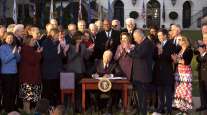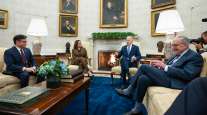Q&A: How Trump Might Try to Fix Bridges and Highways

It’s one point of agreement in a politically polarized government: U.S. highways, bridges and airports are in need of repair and rehabilitation. Like his predecessor, Barack Obama, President Trump says a boost to so-called infrastructure spending would be good not just for roads and bridges but for the workers such projects would employ.
Trump pledged in his victory speech to "rebuild our highways, bridges, tunnels, airports, schools, hospitals," an effort that "will put millions of our people to work." The details are still to come, and the two parties do not see eye to eye on where to find the money.
1. What does Trump say he’ll do?
To fix a system that’s "literally falling apart," Trump vowed, on his transition website, "to invest $550 billion to ensure we can export our goods and move our people faster and safer." He later upped the ante to $1 trillion. And he said he’ll do this while reducing taxes and the national debt.
2. How exactly would he pull that off?
Two Trump campaign senior policy advisers, Wilbur Ross and Peter Navarro, spelled out what Ross — who later became Trump’s pick for commerce secretary — called a "totally self-financing" plan that would produce up to $1 trillion worth of projects at no net cost to the government. The idea: Offer up to $137 billion in income-tax credits to lure private companies — and their cash parked overseas — to needed infrastructure projects. Tax the wages paid to construction workers and the profits collected by the companies. Under their estimates, the tax income balances out the revenue lost to the income-tax credits.
3. Is that realistic?
Trump and his team are hardly alone in suggesting that big public-works projects can pay for themselves in times of low interest rates. But Trump’s potential reliance on private financing is an added challenge. While some toll roads, airports and water systems can produce the revenue needed to make projects profitable, other big-ticket projects might require public dollars to get off the ground. Public-private partnerships, used by nations worldwide to finance long-term infrastructure projects, are another possible route. Trump’s transportation secretary, Elaine Chao, said during her confirmation hearing that such partnerships can "take full advantage of the estimated trillions in capital that equity firms, pension funds and endowments can invest."
4. What’sTrump done so far?
He named two Manhattan real estate developers, Richard LeFrak and Steven Roth, to lead a council of builders and engineers that will oversee his infrastructure program.
5. What are the stumbling blocks?
The tolls that might be needed to make highway work profitable are unpopular, impractical or both in many areas of the country. Republican fiscal hawks in Congress shot down an economic stimulus program built on infrastructure work when Obama was proposing it, and Trump faces similar resistance. House Speaker Paul Ryan says he won’t support infrastructure spending without offsetting budget cuts. LeFrak’s already said that given the political struggle ahead, a $550 billion program might be more reasonable than a $1 trillion one.
6. Is there another way?
A group of Senate Democrats proposed their own $1 trillion infrastructure plan, paid for directly by the federal government.
7. Is the U.S. really ‘falling apart’?
The American Society of Civil Engineers gave America’s infrastructure a grade of D+ on its 2013 report card and estimated that roads, highways, bridges, water systems, schools and transportation systems collectively need $3.6 trillion in investment by 2020. Though civil engineers might be seen as having a stake in painting a dire picture, the raw numbers are pretty bleak: 28% of major urban roads in substandard or poor condition, 240,000 water main breaks each year, 58,791 structurally deficient bridges at the start of the year. The average age of the nation’s fixed assets in 2015 was 22.8 years, the oldest in data back to 1925.
8. Why have highways and bridges been underfunded?
The U.S. collects a federal fuel tax for the Highway Trust Fund, which helps finance improvements to roads, bridges and transit systems. At its inception in 1956, the fund got all its revenue from the fuel tax. Now the tax contributes about 65%, with Congress usually making up the difference out of the general budget. The tax isn’t adjusted for inflation and hasn’t been raised since 1993. Making the problem worse, budget-constrained state and local governments have been reluctant to borrow and spend on infrastructure, especially in the aftermath of the last recession.




